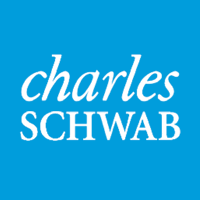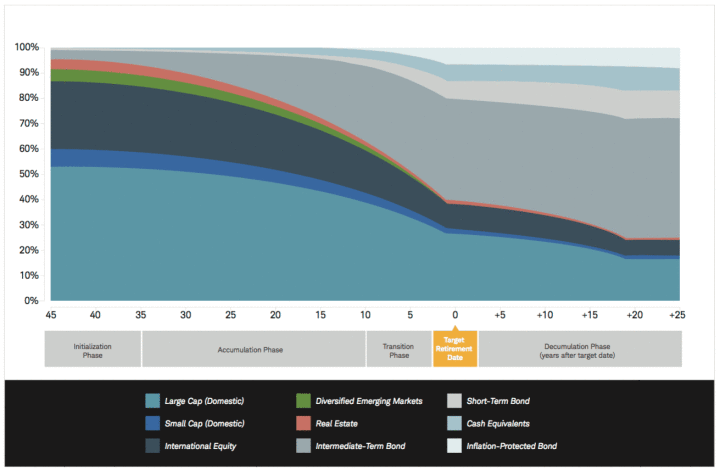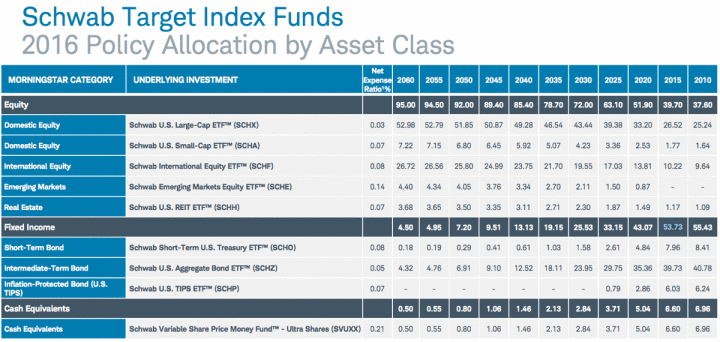
Charles Schwab has announced Schwab Target Index Funds, a new series of “all-in-one” target date mutual funds that are made up entirely of in-house Schwab Index ETFs and a Schwab cash mutual fund. Their existing offering Schwab Target Funds differs in being significantly more expensive and including a mix of passive and actively-managed funds. Each fund will have a target date between 2010 and 2060, spaced in 5-year increments. Let’s take a closer look.
What’s inside? The portfolio for any given target year is composed of 9 different asset classes. Here is a graphical illustration of their “glide path”, or how the asset allocation changes relative to the target retirement date. (Source. Click image to enlarge.)
Here’s a 2016 snapshot of what every fund is holding by target date (Source. Click image to enlarge.):
Overall, the glide path conforms to industry norms, with high equity at younger ages and lower equity as you reach and pass retirement. Here are the ETFs and mutual funds that represent each asset class.
- US Large Cap Equity – Schwab U.S. Large-Cap ETF (SCHX)
- US Small Cap Equity – Schwab U.S. Small-Cap ETF (SCHA)
- International Developed Equity – Schwab International Equity ETF (SCHF)
- Emerging Markets Equity – Schwab Emerging Markets Equity ETF (SCHE)
- Real Estate – Schwab U.S. REIT ETF (SCHH)
- Short-Term Bond – Schwab Short-Term U.S. Treasury ETF (SCHO)
- Intermediate-Term Bond – Schwab U.S. Aggregate Bond ETF (SCHZ)
- Inflation-Protected Bond – Schwab U.S. TIPS ETF (SCHP)
- Cash – Schwab Variable Share Price Money Fund — Ultra Shares (SVUXX)
How much do they cost? What are the investment minimums?
- Individuals can buy Investor Shares with an expense ratio of 0.13%. The minimum initial investment is $100.
- Employer-sponsored retirement plans can access the Institutional Shares with an expense ratio of 0.08%. There is no minimum initial investment.
An interesting thing to note is that the mutual funds technically have an extra layer of management fees and “other fees” on top of the expenses from the underlying ETFs and mutual funds. However, Schwab has agreed to cap the expenses at 0.13% for Investor Shares and 0.08% for Institutional Shares. This is supposed to stay in place “for so long as the investment adviser serves as the adviser to the fund”… they might want to re-word that.
In any case, even with the cap, the Investor Shares still cost more than the expenses from the underlying investments. You are basically paying 0.05% to 0.08% for some simple asset allocation. That means you could build your own portfolio using the same Schwab ETFs at a lower cost. You could also get rid of the (unnecessary in my opinion) cash component, which currently only yields 0.43% with another temporary fee waiver as of 8/26/2016. Personally, that’s what I would rather do, but I will admit that some folks will do better with an automated asset allocation.
How does it compare with Vanguard Target Retirement Funds? This is the natural comparison, as Vanguard’s target funds have the most assets and they used to be the cheapest before Schwab came along. Across the series, the expense ratio for their retail fund varies between 0.14% and 0.16%. You can now see why Schwab has priced their funds just below that at the “sale price” of 0.13%. Schwab loves to be cheaper by a basis point or two.
In terms of asset allocation and glide path, here are some side-by-side comparisons:
- Vanguard has a equity split of 60% domestic and 40% international. Schwab has a equity split of 67% domestic and 33% international (if you consider the 4% US REITs as US stock).
- Vanguard starts at 90% equity max and reaches 50% equity at retirement age. Schwab starts at 95% equity max and reaches 40% equity at retirement age.
- Asset classes that Schwab includes specifically, which Vanguard does not: REITs, inflation-protected bonds (TIPS), and cash.
- Asset classes that Vanguard includes specifically, which Schwab does not: International bonds.
Commentary. Schwab is definitely serious about index funds. They’ve built their own set of low-cost index mutual funds and index ETFs to compete with Vanguard and iShares. They already have an automated portfolio “robo-advisor” called Intelligent Portfolios, which uses these index funds as well as some “smart beta” funds. They’ve added these Target Index funds to grab the 401(k) and individual markets including IRAs. Put another way, they sell flour and butter, and they also sell pre-made pies and cakes.
This is a long-term play for Schwab, as they’ve all but admitted that the index ETFs themselves are currently losing money, while hoping to either make up the difference in other fees, services, or products somewhere down the line (like when interest rates rise again). Schwab will surely grab much more assets from employer retirement plans as a result of this move. In my limited experience with them, I have found Schwab to have solid customer service, at times in fact better than Vanguard. If they can leverage their customer service and human component, I think this is a smart move on their part.
However, if given the choice, I’d recommend my family to buy Vanguard Target Retirement funds first because Vanguard is not a for-profit company and I trust Vanguard more to keep customer interests first over the long run. (I believe that Schwab includes cash where it isn’t necessary in order to increase their future fees from money market funds, which are an important contributor to profits. This isn’t as significant here as in their robo-advisor product, but it will matter more as interest rates rise. More importantly, Vanguard doesn’t play such games.) However, big-picture-wise they are very similar. I’d gladly recommend that they buy a Schwab Target Index fund in their 401(k) or 403(b) plan as they are likely the best options if available. This is a positive development overall for individual investors.


 The Best Credit Card Bonus Offers – 2025
The Best Credit Card Bonus Offers – 2025 Big List of Free Stocks from Brokerage Apps
Big List of Free Stocks from Brokerage Apps Best Interest Rates on Cash - 2025
Best Interest Rates on Cash - 2025 Free Credit Scores x 3 + Free Credit Monitoring
Free Credit Scores x 3 + Free Credit Monitoring Best No Fee 0% APR Balance Transfer Offers
Best No Fee 0% APR Balance Transfer Offers Little-Known Cellular Data Plans That Can Save Big Money
Little-Known Cellular Data Plans That Can Save Big Money How To Haggle Your Cable or Direct TV Bill
How To Haggle Your Cable or Direct TV Bill Big List of Free Consumer Data Reports (Credit, Rent, Work)
Big List of Free Consumer Data Reports (Credit, Rent, Work)
Thanks, Jonathan, for picking up this story so quickly. It was announced only this past Thursday. Any indication of when these index ETFs will be available to individuals?
Both the underlying index ETFs and Target Index mutual funds are also available for purchase. I see them as available to buy in my Schwab PCRA account.
Just curious…on the 2016 Policy Allocation By Asset Class chart, do they have the years at the top going in the wrong order? The way I’m reading it, equities go from 37.6% in 2010 to 95% in 2060. Perhaps I’m reading this incorrectly? Thanks.
It can be confusing… the years across the top are organized by the target retirement date of the fund (name). So 2060 means you are younger and actually plan on retiring in 2060, not that you are looking at a future asset allocation during the year 2060.
If you wanted to see what the asset allocation would look like near actual retirement, you would look at the Schwab 2015 fund at that would mean a target retirement around 2015.
Thanks, Jonathan, for the clarification. Makes perfect sense when you put it that way. Thanks for another great article!
This is an excellent summary! In addition to the cash holding (which is a poor choice for retirement, as you correctly note), I am also struck by the apparent underweight in small cap stocks, and the heavy weighting for international stocks. Any thoughts as to why Schwab might do that?
Small caps are actually overweighted relative to market cap for most of the lifecycle. International stocks are underweighted relative to market cap. It’s home bias that stands in need of justification, not the other way around.
> Schwab loves to be cheaper by a basis point or two.
Fidelity too. In fact, they have a page on their website dedicated to comparing their expense ratios to Vanguard’s, and they’re mostly cheaper by a basis point:
https://www.fidelity.com/mutual-funds/investing-ideas/index-funds
We know that Vanguard operates “at cost,” so that means one of two things: Either Fidelity operates their index funds more efficiently than Vanguard (lower overhead), or Fidelity is selling these funds as “loss leaders” in the hope that customers enticed by these low expense ratios will end up paying for more expensive funds and services.
What do you think, Jonathan?
Fidelity has been in the index fund game longer and may have more assets under management (not sure if Schwab has caught up) so they may not be running as much of a loss as Schwab, but Fidelity has always kind of been “We have index funds, but they are way up there on the dusty top shelf, are you sure you don’t want this shiny actively managed portfolio?”. They refused to disrupt themselves, hoping active would win the day. They have Fidelity Freedom Index funds which are basically a target index fund since 2009, but only in select corporate plans that specifically asked for them, and wouldn’t let individual retail investors buy them at all for 5 years. Then in 2014, they finally decided yeah, okay, I guess this index thing isn’t going away, I suppose you can buy them now…
Good analysis. I always find it odd though, that schwab tends to hold cash in all their portfolios. The smart beta held by their robo is rather a ‘fundamental’ index. Not exactly smart beta, but also not market cap. Ah that weird iterim of stuff that exists.
Nice analysis, but something caught my eye:
“Vanguard is not a for-profit company and I trust Vanguard more to keep customer interests first over the long run.”
There’s a common misconception about the term “nonproft”. It just means outside investors can’t buy stock in Vanguard in return for a share of profits. But the company can absolutely make a profit and use it to retain the earnings in-house, invest in operations, overpay the CEO, etc. just like a for-profit can.
Where can i get the updated figures for the 2016 Policy Allocation By Asset Class chart?